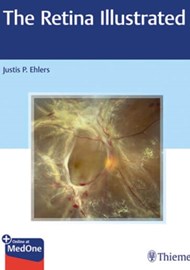I’ve always liked googling authors of the textbooks we get sent rather than relying on the very obviously bias blurb about them presented in the book. When I got Retina Illustrated I have to admit I was pretty excited to see the editor was Justis Ehlers; a Vitreoretinal Surgeon (who does many, many other things alongside that) who works at the prestigious Cleveland Clinic. So expectations were high.
The textbook itself is fairly sizeable – about two thirds the size of my Kanski. Once you have the textbook, you’re meant to get complimentary access to the full e-book so you can easily reference it anywhere you are, no need to worry about lugging it around. It’s a little bit different to the other textbooks I’ve received recently which tend to offer an additional multimedia library online to compliment the text as opposed to the same text online.
In terms of organisation the book is split into 10 main sections, and 102 chapters which are around five pages each. As the title of the text suggests, the majority of it is diagrams and pictures. I think we can all agree that ophthalmologists are a very visual bunch, so this set up will definitely appeal.
The first section is dedicated to retinal diagnostics. You get a quick overview of optical coherence tomography (OCT), fundus fluorescien angiography (FFA), optical coherence angiography (OCTA), indocyanine green (ICG), intraoperative OCT and fundus autofluorescence (AF). For each test they give a ‘diagnostic / technology’ overview and then talk about their key applications. They seem to give a good balance of how each test works without getting overly technical. So you can leave this chapter having a fairly decent, albeit basic understanding of each one and the types of conditions they may be useful in.
The other main sections in the book are:
- Macular and peripheral vitreoretinal interface disorders
- Retinal vascular disease
- Retinal degenerations and dystrophies
- Other macular disorders
- Chorioretinal infectious and inflammatory disorders
- Retinal trauma and other conditions
- Toxic and drug-related retinopathies
- Posterior segment tumours
- Paediatric vitreoretinal disease
Each section reminds me of the kind of notes that I tend to make for an exam – they’re to the point and just give you the most important bits of information. As expected there are lots of fundus pictures, OCTs, FFAs etc. for each condition. They do have some nice little tables thrown in there as well, such as the two tables summarising the differences in examination findings and the findings in diagnostic tests for central serous chorioretinopathy (CSCR) and the pachychoroid disease spectrum.
I like how it’s succinct whilst covering a lot of ground. I’d probably recommend the ebook over the hard copy as the images tend to look much better online.
Retina is quite saturated with lots of textbooks boasting beautiful diagrams so it can be difficult to know which to get. Although I’m not convinced this adds anything new, if you want a textbook that whips you through a lot of retinal conditions in a concise manner then this may well be worth a look.




